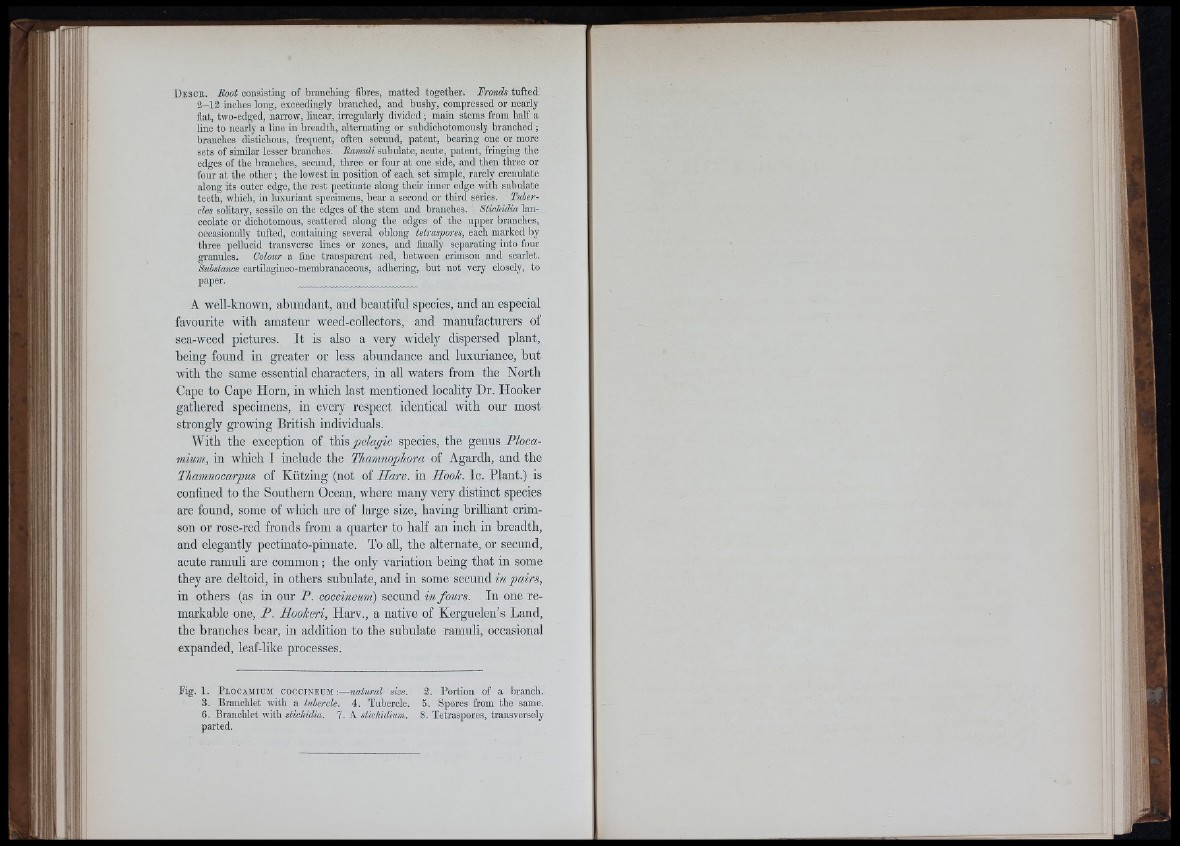
IIIJ ‘
I//;! I
iii',! I
D e s c b . Root co n s is tin g o f b ra n c h in g fibres, m a tte d to g e th e r. Fronds tu f t e d
3 - 1 3 in ch e s lo n g , ex c eed in g ly b ra n c h e d , a n d b u sh y , com p re s sed o r n e a rly
fla t, tw o -ed g ed , n a rrow , lin e a r, irre g u la rly d iv id e d ; m a in s tem s from h a l f a
lin e to n e a rly a lin e in b r e a d th , a lte rn a tin g o r su b d ich o tom o u s ly b r a n c h e d ;
b ran c h e s d is tich o u s , fre q u e n t, o fte n s c tu n d , p a t e n t, b e a rin g o n e o r m o re
se ts o f s im ila r le sse r b ra n c h e s . RamuU s u b u la te , a c u te , p a te n t, frin g in g th e
ed g e s o f th e b ran ch e s, s eo u n d , th r e e o r fo u r a t o n e side, a n d th e n th r e e o r
fo u r a t th e o th e r ; th e low e s t in p o s itio n o f e a ch s e t sim p le , ra re ly c ren u la te
a lo n g it s o u te r ed g e , th e r e s t p e c tin a te alo n g th e ir in n e r ed g e w ith s u b u la te
te e th , w h ich , in lu x u r ia n t sp ecimen s, b e a r a s e co n d o r th i r d serie s. Tubercles
so lita ry , sessile o n th e ed g e s o f th e s tem a n d b ra n c h e s . Stichidia la n ceo
la te o r d ic h o tom o u s , s c a tte re d a lo n g th e ed g e s o f th e u p p e r b ran ch e s,
occ asionally tu fte d , c o n ta in in g sev e ra l o b lo n g tetraspores, each m a rk e d b y
th r e e p e llu c id tra n sv e rs e lin e s o r zone s, a n d fina lly sep a i'a tin g in to fo u r
g ra n u le s . Colour a fine tr a n s p a re n t r e d , b e tw e e n c rim so n a n d sc a rle t.
Substance c a rtilag in eo -m em b ran a c eo u s , a d h e rin g , b u t n o t v e ry closely, to
p a p e r, __________^ ^
A well-known, abundant, and beautiful species, and an especial
favourite witb amateur weed-collectors, and manufacturers of
sea-weed pictures. It is also a very widely dispersed plant,
being found in greater or less abundance and luxuriance, but
witb tbe same essential characters, in all waters from tbe Nortb
Cape to Cape Horn, in wbicb last mentioned locality Dr. Hooker
gathered specimens, in every respect identical with our most
strongly growing British individuals.
With tbe exception of pelagic species, the genus Plocamium,
in which I include tbe Thamnophora of Agardh, and the
Thamnocarpm of Kutzing (not of Harv. in Hook. Ic. Plant.) is
confined to the Southern Ocean, where many very distinct species
are found, some of which are of large size, having brilliant crimson
or rose-red fronds from a quarter to half an inch in breadth,
and elegantly pectinato-pinnate. To all, the alternate, or secund,
acute ramuli are common; the only variation being that in some
they are deltoid, in others subulate, and in some secund in pairs,
in others (as in our P. coccineum) secund in fours. In one remarkable
one, P. Hookeri, Harv., a native of Kerguelen’s Land,
tbe branches bear, in addition to the subulate ramuli, occasional
expanded, leaf-like processes.
If I 1 }
Fig, 1. P lo c am ium c o c c in eu m :— natural size.
3. Branchlet with a tubercle. 4. Tubercle.
6. Branchlet with stichidia. 7. A stichidium.
parted.
3. Portion of a branch.
5. Spores from the same.
8, Tetraspores, transversely
i i i